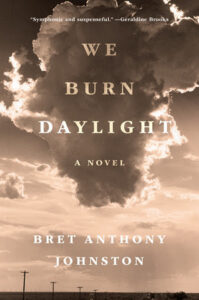This first appeared in Lit Hub’s Craft of Writing newsletter—sign up here.
Article continues after advertisement
Solid Ground
Years ago, when a reader asked the Nigerian novelist Uwem Akpan how to evoke place in fiction, he said stop describing the sky. This was in a swanky theater—elegant amber light, pin-drop acoustics, waxed hardwood stage—so I resisted the impulse to climb atop my plush seat, pump my fist, and holler, “You tell ‘em, Uwem!”
Despite its reassuring vastness and serviceably moody clouds, there’s not a whole lot of difference between the patch of sky over Waco and the patch over Lagos. Instead, Akpan suggested, focus on the ground, the dirt. The ground varies depending on the locale. And it’s imprinted with the unique stories of the people who cross it, who plant seeds and posts in it, who are ultimately buried in it. I also think it matters that characters—like authors, like readers—interact with the ground in ways they never will the sky, which is why terra firma reveals so much about us, about our place in the world. Setting isn’t a backdrop for the story, it’s the foundation.
A Brief Note on Skateboarding
Like most skateboarders, I pay a lot of attention to the ground, and because I fall constantly, I spend a lot of time picking myself up off it. Even when I’m not skating, I have a habit of assessing a given surface’s skateability: is the concrete cracked or polished? Is the space between pavers wide enough to grab a wheel and send me face first to the curb? How steep is that sidewalk’s downhill slant; what will I find—Smash into? Ragdoll over?—at the bottom of the hill with the speed I’ve gathered?
These factors—and countless more I’m sparing you—determine not just if a spot is skateable, but if it’s worth skating. The surface affects the way you roll, how much it will hurt when you abruptly and unexpectedly stop rolling. But there’s a flipside to this issue, and that’s where it becomes helpful in a discussion of place in fiction: the less friendly a spot is, the more it means to skate it. That is, if a skater does a simple boardslide down a steep and/or kinked handrail with a buckled runway and a landing area that drops straight into a janky, ankle-busting gutter, it matters far more than doing a gnarlier trick on a perfect rail in a skatepark.
“Context makes content.” That’s how Rodney Mullen, widely regarded as the greatest skateboarder to ever live, sums it up in one of his brainy TED Talks. In the most reductive terms, he’s saying that where you do a trick matters as much as, and quite possibly more than, the trick itself. He’s saying certain spots have the power to transfigure the essence of the trick and maybe even the skater, that there’s a kind of kinetic and architectural alchemy at play, and the product of that alchemy might accurately be called relevance. For our purposes, he’s saying: Place makes character
Students
When I talk with students about place in fiction, we’re usually at a seminar table. There’s the hum of an HVAC system and occasional sounds of writers snacking on energy bars. We might be discussing place in one of their pieces or a book from the shelves behind us. Maybe someone is reading aloud while the rest listen with closed eyes, trying to identify when and how the language animates the imagined locale in our consciousness. The students make wise observations and offer actionable advice; one may invoke Akpan’s charge to stop describing the sky.
Then, as the talk is winding down, I ask them to imagine our having the exact same conversation not at a table in a room full of books, but in a football stadium where some of us are down on the field and others are up in the stands and still others are in the tunnel. Or what if we were crammed into the basket of a hot air balloon, floating over a busy freeway? Or in a mosh pit or cathedral or atop a building in the nation’s capital with a bunch of pigeons flapping around, pecking at our pages. How would those settings affect our discussion, our ability to speak and listen and comprehend?
“We’d have to use bullhorns,” someone will say. “Or whisper.”
And then, someone else, “I’m afraid of heights, so no can do on the balloon. Hard pass.”
And then, “I’ve always wanted to stage-dive. You fools better catch me!”
And then, “I guess it would change everything.”
And then, “Even us.”
Exactly.
About Those Pigeons
“The Girl Who Raised Pigeons” is the stunner that opens Lost in the City, the debut collection by Edward P. Jones. The story is so deeply felt that it breaks and mends your heart sentence by sentence. (Honestly, you should just stop reading my junior varsity blathering and direct your full attention to Jones’s fiction, which will lay bare everything you need to know about place and pretty much everything else, too.) The story concerns a father granting his daughter’s wish to raise pigeons on the rooftop of their D.C. apartment building. Here’s a taste:
Sometimes, when the weather allowed, the girl would sit on the roof plaiting her hair or reading the funny papers before school, or sit doing her homework in the late afternoon before going down to Miss Jenny’s or out to play. She got pleasure just from the mere presence of the pigeons, a pleasure that was akin to what she felt when she followed her Aunt Thelma around her house, or when she jumped double-dutch for so long she had to drop to the ground to catch her breath. In the morning, the new sun rising, she would place her chair on the roof’s edge. She could look down at tail-wagging Bosco looking up at her, down through the thick rope fence around the roof that Robert had put up when she was a year old… And in the evening she watched the pigeons return home, first landing in the oak tree, then over to the coop’s landing board. A few of them, generally the males, would settle on her book or on her head and shoulders…
If you’re reading it for the first time, did you notice when the roof came into focus? For most readers, it happens when the girl moves her chair near the edge and looks down at sweet Bosco. Jones doesn’t limit his rendering of place to description and imagery, but rather he also shows the character interacting with her surroundings. He’s using fixed (the roof) and moveable (the girl, the chair, the pigeons) parts. He’s using density, depth, and motion. Think of it like this: instead of giving you a circle, he gives you a sphere, a ball. Then he balances it on the girl’s finger. Then she spins it.
Dreaming by the Book
If you’re not familiar with Elaine Scarry’s seminal text on imaginative perception, then let’s put that sucker on the pile with Lost in the City. The book is a marvel I have no business summarizing, but two of its assertions are apropos here. First, Scarry maintains that certain aspects of a writer’s craft amount to a set of “instructions” for the reader’s perception. She writes, “[I]n imagining the sweep of the wind across the moors, we perform a mimesis of actually hearing the wind. Imagining is an act of perceptual mimesis, whether undertaken in our own daydreams or under the instruction of great writers.”
So when I described the swanky theater where Akpan did his reading, you processed that description much as you would my handing you a recipe for jambalaya. The crucial difference, of course, is also the miracle and mystery of literature: I’m giving you a recipe for a dish made from ingredients that somehow exist in your imagination despite being, to cite Scarry again, “almost wholly devoid of actual sensory content.”
Context makes content. Fixed and moving parts. Stop describing the sky. This is how writers bamboozle readers. Which might sound kind of obvious or deceitful, but what if this bamboozling isn’t a shell game, but an open-armed appeal.
And yet, you probably did picture some version of that theater, especially when you imagined me almost climbing onto my seat and pumping my fist. The same way you envisioned, however fleetingly, the busy freeway when you imagined the hot air balloon floating over it, and that rooftop when you thought of the girl arranging her chair near the edge and her pigeons landing on her book. We see place most vividly when we see a character move within in it, through it, in front of it. Place isn’t just window dressing; it’s the window itself, and it’s clearest when a character unexpectedly catches their reflection on the darkened glass.
To wit, here’s Scarry again, with some support from psychologist J.J. Gibson: “If one surface passes in front of another surface—a picture dropping from a wall (Gibson’s example) or, more simply, my hand passing over my face—the movement of the object ‘progressively covers and uncovers the physical texture of [the object behind it].’… It is impossible to create imaginary persons if one has not created a space for them.”
Bamboozle
All of this, not least Scarry’s suggestion that we cannot have imaginary characters without imaginary places, returns me to Edward P. Jones. Years ago, in another posh theater packed with readers, someone asked Jones how much research he did for his books. He offered some examples, then upon realizing the question was less about his writing practice and more about the seemingly impossible task of creating a world the reader can trust, he took a deep breath and regrouped. Finally, he said, “The thing about this writing stuff is, as long as you bamboozle the reader, you’re fine.”
Context makes content. Fixed and moving parts. Stop describing the sky. This is how writers bamboozle readers. Which might sound kind of obvious or deceitful, but what if this bamboozling isn’t a shell game, but an open-armed appeal. Maybe our “instructions” are actually invitations. We’re inviting readers to different places, but it’s also much more than that: we’re soliciting their help to build the places our characters need to exist.
In fiction, place is where the writer and reader first collaborate. Once the reader tests the foundation and risks that initial step onto the terra firma that emerges from nothing but language and imagination, they commence working alongside the writer to pave the roads and buckled sidewalks the characters will travel. They help erect the walls on which the characters will hang a picture, the floor that will shatter the frame when it falls. But those walls and floors—and the swanky theaters, classrooms, and rooftops—also provide shelter. Shelter for the characters, the readers, and, yes, even the writer. Shelter from doubt, from what might accurately be called irrelevance, and ironically enough, from the overwhelming impermanence of the real world. The places in fiction are fashioned from oblivion, they are less than air, and yet they’ll be standing long after their architects have been placed in the ground, covered in the particular dirt of home.
________________________________________

Bret Anthony Johnson’s We Burn Daylight is available now via Random House.

